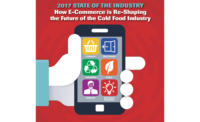In 2019, the topic of price will be on the agenda for both manufacturers and retailers, according to a study released by Acosta, Jacksonville, Fla. With increasing transportation and commodity costs, manufacturers will be forced to increase price. Retailers will be aggressively scrutinizing price inflation to stay competitive in a fragmenting retail environment.
Here are some additional trends and predictions:
Resurgence of frozen. After several years of decline, manufacturers have finally cracked the code on getting shoppers back into the frozen food aisle with cleaner labels and higher quality products that appeal to shoppers. Shoppers are coming to the realization that frozen is healthy and convenient, with dramatic improvements in quality and variety of prepared foods.
E-commerce. Brick-and-mortar operators will continue to catch up with pure plays like Amazon. Online retailers will continue to move selectively into brick-and-mortar spaces, or partner with established retailers to grow reach of their brands. Click-and-collect will continue to emerge as retailers refine their implementation.
Continued renaissance of the in-store shopping experience. Convenience, the ability to browse and sample, and immediacy will continue to be the key draws. Other predictions for in-store shopping changes in 2019:
§ Prepared foods and eating spaces
§ Services
§ Individualization of experience
§ Sampling, education and entertainment
§ Integration with smartphones—deals, navigation, checkout and personalized offers
§ Possible advances in mobile pay
Smaller store footprints due to the slow death of the mall. Anchor spaces will continue to be repurposed to entertainment and lifestyle, like cinemas, video gaming and even grocery, to drive traffic. Expect to see pop-up stores fill empty retail storefronts for seasonal or promotional “limited-time only” periods.
Grocery home delivery. Acosta predicts less cooking from scratch, with grocery home delivery expanding to include prepared foods and complete meals. These changes require the development of infrastructure of meal prep and additional delivery logistics. E-commerce and home delivery create increased stress on trucking and delivery networks and the infrastructure they depend on. Cardboard and other packaging suppliers and packaging waste will add to refuse challenges.
Omnichannel experience. Retailers will focus on the “omnichannel experience,” including physical store formats and digital experience such as click-and-collect.
Naturally derived wellness additives. CBD-derived products will continue to rise in popularity. The stigma of being related to cannabis will continue to decline, as marijuana legalization expands and recognition of medicinal value grows.
Shopping trip composition changes. Stocking up/pantry load could be a thing of the past. Shoppers are shifting away from stock-up/pantry load to quick/fill in.
Return to premiumization. As the recession fades and the value equation now favors quality, convenience and healthiness over pure price, big food CPGs will rationalize product mix and acquire relevant challenger brands.
Health services will expand. Health services will continue to expand in retail.


